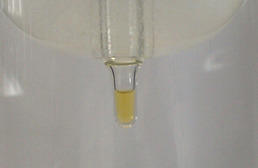Fluorine Chemistry
Our main interest is the investigation of novel inorganic compounds. One of the most efficient techniques to investigate species in their highest attainable oxidation states is the combination of experimental fluorine chemistry, matrix-isolation spectroscopy, and quantum-chemical calculations and can be summarized as “Computer Aided Synthesis of New Species”. These combination can help to investigate the last missing secrets of high oxidized species.
One promising access into the synthesis of such species is by preparation of highly fluorinated compounds which can be used as precursor materials for new compounds stabelized and investigated by matrix-isolation experiments. This combination of experimental techniques should result in a significant extension of the chemistry of this little studied field of high-valent fluorine compounds and our understanding of transition metal and main group species in their highest oxidation states and at the limits of coordination.
This is by no means only of academic interest, because several industrial processes employ highly oxidized species directly or as intermediates, and the precise mechanism is often still under debate and therefore demands further investigation.
Further topics of interest are:
- the investigation of fluorophilicity
- controlled activation of fluorine
- metal fluorides in industial processes
- selective fluorination
- investigation of unusul fluorine species as intermediates
Reviews:
The highest oxidation states of the transition metal elements
S. Riedel, M. Kaupp, Coord. Chem. Rev. 2009, 253, 606-624.
High-Valent Fluorides and Fluoro-Oxidizers
S. Riedel, in Comprehensive Inorganic Chemistry II, Vol. 2 (Eds.: J. Reedijk, K. Poeppelmeier), Elsevier, Oxford, 2013, 187–221.

